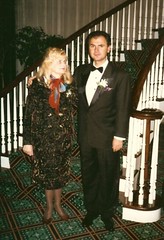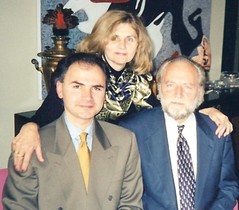Category Archives: Italian Painters
Leonardo da Vinci, Titian, Raphael, Botticelli
Andrea Mantegna (1431-1506)

Mantegna (detail of Minerva expelling the vices from the garden of virtue), a photo by Martin Beek on Flickr.
Andrea Mantegna (Detail of Minerva expelling the vices from the garden of virtue)
Andrea Mantegna (1431-1506)

Mantegna (detail of Minerva expelling the vices from the garden of virtue), a photo by Martin Beek on Flickr.
Via Flickr: Detail of Minerva expelling the vices from the garden of virtue.
In the 15th century Italy the fashionable thing to do was to have a studiolo, which was a type of private study, which would be set aside for intellectual activities. Isabella d’Este, the Marchesa of Mantua, one of the leading women of the Italian Renaissance, was a major cultural figure of that time and a patron of the arts. In 1490, she decided to create a studiolo in a tower of the Castello di San Giorgio and she commissioned Andrea Mantegna to paint two canvases to hang in the room, entitled Parnassus and Minerva, which she would have positioned opposite each other in the study. Her biographer wrote:“…It was Isabella’s dream to make this Studiolo a place of retreat from the world, where she could enjoy the pleasures of solitude or the company of a few chosen friends, surrounded by beautiful paintings and exquisite works of art….. In this sanctuary from which the cares and the noise of the outer world were banished, it was Isabella’s dream that the walls should be adorned with paintings giving expression to her ideals of culture and disposing the mind to pure and noble thoughts…”
Massimo Campigli (1895-1971) – Portrait of a Lady (1924)

Campigli, Massimo (1895-1971) – 1924 Portrait of a Lady (Galleria Civica di Arte Moderna e Contemporanea, Turin, Italy), a photo by RasMarley on Flickr.
Massimo Campigli (1895-1971), Portrait of a Lady (1924) , Galleria Civica di Arte Moderna e Contemporanea, Turin, Italy
Massimo Campigli (1895-1971) – Boats (Christie’s London, 2006)
Via Flickr: Oil on canvas. 93.4 x 114.5 cm. Christie’s London, 2006
Massimo Campigli (1895-1971) – His Wife Who Lifts the Veil (1941-42)

Campigli, Massimo (1895-1971) – 1941-42 His Wife Who Lifts the Veil (National Gallery, Ljubljana, Slovenia), a photo by RasMarley on Flickr.
Via Flickr: Oil on canvas; 63 x 41 cm. National Gallery, Ljubljana, Slovenia
Campigli, Massimo (1895-1971) – The Theater Actresses (1940-42)

Campigli, Massimo (1895-1971) – 1940-42 The Theater Actresses (Museo di Arte Moderna e Contemporanea, Trento, Italy), a photo by RasMarley on Flickr.
Via Flickr: Oil on canvas; 97.5 x 146.5 cm. Museo di Arte Moderna e Contemporanea, Trento, Italy
Massimo Campigli (1895-1971) – The Gypsies (1928)

Campigli, Massimo (1895-1971) – 1928 The Gypsies (Museo di Arte Moderna e Contemporanea, Trento, Italy), a photo by RasMarley on Flickr.
Via Flickr: Oil on canvas; 96.5 x 75.5 cm. Museo di Arte Moderna e Contemporanea, Trento, Italy
Massimo Campigli (1895-1971) – Two Women (1952)

Campigli, Massimo (1895-1971) – 1952 Two Women (Christie’s New York, 1999), a photo by RasMarley on Flickr.
Via Flickr: Oil on canvas; 82 x 63.4 cm. Christie’s New York, 1999
Massimo Campigli (1895-1971) – The Metro (1952)

Campigli, Massimo (1895-1971) – 1952 The Metro (Sotheby’s London, 2004), a photo by RasMarley on Flickr.
Via Flickr: Oil on canvas; 144.5 x 113 cm. Sotheby’s London, 2004
Massimo Campigli (1895-1971) – Seamstresses (1925)

Campigli, Massimo (1895-1971) – 1925 Seamstresses (The State Hermitage Museum, St. Petersburg, Russia), a photo by RasMarley on Flickr.
Via Flickr: Oil on canvas. 161 x 96.5 cm. The State Hermitage Museum, St. Petersburg, Russia
Massimo Campigli, born Max Ihlenfeld, was an Italian painter and journalist. He was born in Berlin, but spent most of his childhood in Florence. His family moved to Milan in 1909, and here he worked on the Letteratura magazine, frequenting avant-garde circles and making the acquaintance of Boccioni and Carrà. During World War I Campigli was captured and deported to Hungary where he remained a prisoner of war from 1916–18. At the end of the war he moved to Paris where he worked as foreign correspondent for the Milanese daily newspaper. Although he had already produced some drawings, it was only after he arrived in Paris that he started to paint. At the Café du Dôme he consorted with artists including Giorgio de Chirico, Alberto Savinio, Gino Severini and Filippo De Pisis. Extended visits to the Louvre deepened Campigli’s interest in ancient Egyptian art.His first figurative works applied geometrical designs to the human figure, reflecting the influence of Pablo Picasso and Fernand Léger as well as the Purism of “L’Esprit Nouveau”. In 1923, he organized his first personal exhibition at the Bragaglia Gallery in Rome. During the next five years his figures developed a monumental quality, often with stylized poses and the limbs interwoven into a sculptural solidity. The importance given to order and tradition, the atmosphere of serenity and eternity were in line with the post-war reconstruction and the program of the “Twentieth Century” artists with whom Campigli frequently exhibited both in Milan from 1926–29 and abroad from 1927–31. In 1926 he joined the “Paris Italians” together with Giorgio de Chirico, Filippo de Pisis, Renato Paresce, Savinio, Severini and Mario Tozzi. In 1928, year of his debut at the Venice Biennial, he was very much taken by the Etruscan collection when visiting the National Etruscan Museum in Rome. He then broke away from the compact severity of his previous works in favor of a plane with subdued tones and schematic forms rich in archaisms.During a journey in Romania he started a new cycle of works portraying women employed in domestic tasks and agricultural labor. These figures were arranged in asymmetrical and hieratic compositions, hovering on a rough textured plane, inspired by ancient fresco. These works were enthusiastically received by the critics at the exhibition held in the Jeanne Bucher gallery, Paris, in 1929 and at the Milione Gallery, Milan, in 1931. During the ‘thirties he held a series of solo exhibitions in New York, Paris and Milan which brought him international acclaim. In 1933 Campigli returned to Milan where he worked on projects of vast dimensions. In the same year he signed Mario Sironi’s Mural Art Manifesto and painted a fresco of mothers, country-women, working women, for the V Milan Triennial which unfortunately was later destroyed. In the following ten years other works were commissioned: I costruttori (“The builders”) for the Geneva League of Nations in 1937; Non uccidere (“Do not kill”) for the Milan Courts of Justice in 1938, an enormous 300 square metre fresco for the entrance hall, designed by Gio Ponti, of the Liviano, Padua which he painted during 1939–40. He spent the war years in Milan and in Venice, then after the war they divided his time between Rome, Paris and Saint-Tropez. In a personal exhibition at the Venice Biennial in 1948 he displayed his new compositions: female figures inserted in complicated architectonic structures. During the 60s his figures were reduced to colored markings in a group of almost abstract canvasses. In 1967 a retrospective exhibition was dedicated to Campigli at the Palazzo Reale in Milan.



